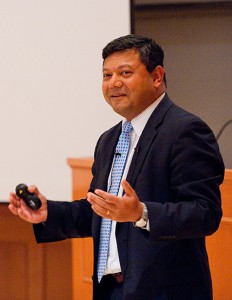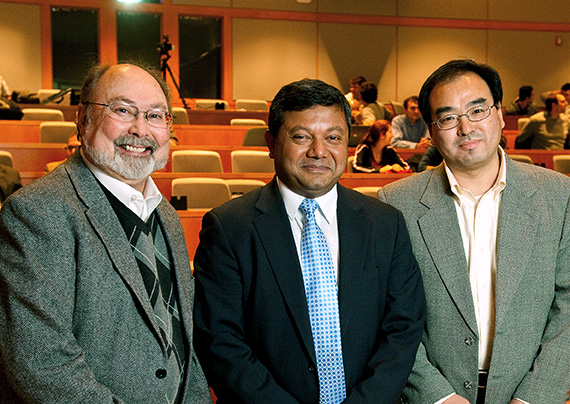Seeking game-changing energy technologies
by David Salisbury

“Gentlemen, we have run out of money. It’s time to start thinking.”
This quote, attributed to the New Zealand physicist Ernest Rutherford, summarizes the main point of the presentation that the director of the newest federal research agency, the Department of Advanced Research Projects Agency–Energy (DARPA-e), gave on campus this week.
The speaker was Arun Majumdar, the distinguished mechanical engineer from University of California Berkeley whom Energy Secretary Stephen Chu tapped to set up the new organization, which has the ambitious goal of identifying and funding game-changing energy research.
The occasion was the School of Engineering’s annual Hall Lecture.
There is an old engineering joke: To the pessimist, the glass is half empty; to the optimist, the glass is half full; to the engineer, the glass is the wrong size.
Majumdar’s talk illustrated the joke’s punchline by providing an exquisite engineer’s view of the critical energy situation that we face.
First, he drew a sober view of the global energy situation, including the nation’s current $1 billion per day appetite for imported oil, the accelerating rate of climate change and predictions of rocketing global energy demand as a steadily growing proportion of the world’s seven billion plus people adopt western life styles.
Instead of giving into Malthusian depression, however, Majumdar cheerfully maintained that what we need is a paradigm change: “how to grow in a sustainable way.” These new technologies will, by their very nature, be disruptive. But they will be less disruptive if we develop them, instead of someone else, and the nation would reap the economic benefits as well, he maintained.
It would not be the first time that science has produced such a game changer, he pointed out. At the turn of the century Europe was facing impending starvation. In 1898, Sir William Crookes, the president of the British Association for the Advancement of Science, he described the problem and issued a call to European chemists to turn starvation into plenty. The basic problem was a lack of supplies of nitrogen fertilizer. A young German physical chemist Fritz Haber was one of those who responded to Crookes’ call to arms: he discovered that uranium acted as a catalyst that allowed him to remove nitrogen from the air and convert it into ammonia efficiently. His discovery inspired BASF chemist Carl Bosch to scale up the process to commercial levels and by 1912 the Haber-Bosch process was a viable means of producing fertilizer. This breakthrough and its social and political ramifications are described in an article titled The Nitrogen Bomb published in Discover magazine in April 2001.
“If it weren’t for this discovery most of us would not be here today,” Majumdar pointed out, and then went on to describe some of the possible game-changing projects that DARPA-e has decided to back:
- Using genetic engineering to insert the oil-producing capability of algae into the tobacco plant and to increase the turpentine production of pine trees by as much as 20 percent;
- Developing liquid metal batteries based on a process used in aluminum manufacturing which have potential energy densities twice that of current batteries at one third the cost;
- Replacing the 100,000 pound transformers in the aging electrical grid with solid-state transformers that weigh about 100 pounds;
- Transforming the current electric grid from a passive system where electric power flows along the path of least resistance to a dynamic system, similar to the internet, where the output of individual generators can be routed to specific destinations, potentially increasing its reliability and efficiency.

As intriguing as these possibilities are, Majumdar admitted that technological innovation by itself will not be sufficient. Low-cost, long-term capital must be available to develop these breakthroughs. Public policy must encourage their development. And our educational system must provide the knowledge and training required to develop and then to operate these new technologies and, finally, society must actively support their development.
“We need innovation in all these areas: We must bring them into alignment,” Majumdar concluded.
It very well could be that the institutional innovations required will be more difficult to achieve than the technological ones.
Contact: David Salisbury

Leave a Response